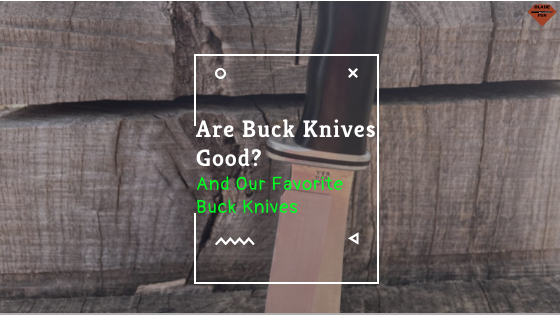Buck knives are a staple in our collection and have been ever since we started buying knives. But when you first start out buying knives, you don’t have quite the frame of reference needed to tell whether or not they’re good. So, what do we think of Buck knives now?
Here is the short answer:
Buck makes good mid- to high-price knives for outdoorsmen. They primarily use 420HC steel, which isn’t the best steel from most companies, but Buck is great with 420HC. They’ve got a variety of knives and tools–with hunting knives being among their best. Overall, they’ve got some great knives.
Now let’s take a look at what Buck knives are known for, the history of Buck knives, how well the knives work, and what our favorite Buck knives are.
What is Buck known for?
Buck is pretty popular for its Buck 110 folding knife. They also have some other classic knives, too. Some examples are the 103 Skinner and Woodsman.
Buck is overall known to have some pretty classic designs. Some might call them old-timey, but they’re tried and true designs that’ll stand the test of time.
Buck Knives History
Buck was founded by Hoyt Buck in 1902. He saw a good knife, admired it, and wanted to make his own. And he did just that.
After his son’s service in the United States Navy, Hoyt Buck’s son moved to San Diego, California, where Hoyt would start his company with his son. Together, they began selling knives under the company name H.H. Buck and Son.
After the death of Hoyt Buck, Al Buck (Hoyt’s son) renamed the company in 1961, under the name Buck Knives INC., which would be the last re-naming. Al introduced his son Chuck to the business soon after the renaming.
Chuck took over the company as CEO and went on to make many of the more popular knife designs they have today. In 1999, Chuck handed down the company to his son CJ, and he’s remained the CEO of the company through today.
So, it’s a family-owned business with good designs and nice knives.
How Good Are Their Knives?
Buck has been around for 4 generations, so they know a thing or two about making knives. Let’s dive a little bit deeper into it all, though.
Steel
The blade steel Buck uses is primarily 420HC, which is not known to be the best steel if it’s made in countries other than the USA or Europe. Luckily, Buck makes their steel in the US, so it’s top-tier.
Buck is generally known to have good steel on all their knives. Although I have had some minor chipping on some of the knives I own, for the most part, they have good steel for the price.
Grips
Buck has very comfortable grips made out of black phenolic, DymaLux, Green canvas Micarta, or G-10. All the knife grips Buck has will fit well in the hand of virtually any user and feel good to use.
There can sometimes be one downside to the handles, though: Some of them have an aluminum pommel on them. Sometimes, this leads to the knife getting cold, which will spread to your hand. And cold hands aren’t usually that fun.
How Do They Compare to Other Knife Companies?
Buck has a lot of competitors, so how does Buck line up compared to them? Well, here is Buck compared to other knife companies in a similar price range.
Buck vs Gerber
Buck and Gerber are some of my favorite knife companies of all time. And they are big competitors to each other. But, which one makes better knives? Let’s compare a few different points:
- Price. The price tag on Gerber and Buck knives are very similar. It depends on the knife, but for the most part, a fixed blade Buck knife will cost $100, and Gerber about $75. This will vary on the knife size, blade steel, and grip material but, Gerber generally makes less expensive knives.
- Durability. As far as durability goes, both companies are neck and neck. They both make great knives, but Gerber uses better steel than Buck, making the knives just a little stronger. I have had Buck knife blades chip, but I have never had a Gerber knife chip–only go dull. So, in general, I’d say Gerber wins this one.
- Grip. Buck wins this one. Buck knife handles just fit better, and don’t have any edges that will cause blisters. I have never gotten a blister from a Buck knife, but I’ve gotten plenty from Gerber knives. Gerber tends to have “grippier” knife handles, which makes you more likely to give you blisters.
Overall, I’d say they’re about even. They each have things going for them. If you like cheaper knives with different steel than 420HC, then Gerber’s probably the preferred one.
Buck vs Kershaw
Kershaw is one of my favorite knife brands out there, but are they better than Buck? Well, yes and no. Here’s why:
- Steel. Both companies have good steel, and the knives will hardly ever chip or break on you. I have had about the same experience with both companies; they will chip if you use them a lot, and they will eventually go dull, but I have broken the tip off one of my Kershaw knives, so Buck wins.
- Cost. Kershaw has Buck beat when it comes to price. A Kershaw folding knife costs about 30 dollars, while Buck costs about 50 dollars. And Kershaw fixed blades cost about $70 and Buck costs $100.
Which one is better? I think Buck makes better knives than Kershaw when it comes to fixed blade knives, but not folding knives. Kershaw specializes in folding knives, while Buck is more fixed-oriented. There are only a few fixed blade knives that Kershaw makes vs. Buck has a whole array of fixed blades, and vice versa for folding knives.
Our Favorite Buck Knives
We have tested a lot of Buck knives, and out of all the Buck knives we tested, we found a few that stood out from the bunch. Here are our favorites:
The 103 Skinner
The 103 Skinner is for skinning game animals. It has a wide belly made for sweeping motions and a blunt tip, so you don’t cut through the hide of your game animal. I like this knife for chopping tasks because it has a wider, heavier belly.
The blade is 0.120 inches in diameter, with a Skinner blade shape. It’s a pretty average length knife at 8.25 inches long and is very light at 4.3 ounces.
There are three different versions of the 103 Skinner: There is the Pro Knife, the Heritage, and the Standard.
The Pro knife has a $165 MSRP, S35VN blade steel, and a green canvas micarta handle.
The Heritage knife has a $99 MSRP, a D2 steel blade, and a DymaLux handle.
The Standard 103 Skinner which is least costly at $79 MSRP, has a 420HC blade, and a black phenolic handle.
All of the knives in the Skinner series have an aluminum pommel and a leather sheath.
Check out the 103 Skinner here!
The 120 General Knife
The General knife is for all, well, general knife duties. I like using this knife if I need a good all-around knife that won’t fail on me.
The General knife has a clip-point blade that is 0.175 inches in diameter. The General is a bigger knife at 12 inches long, and 8.3 ounces.
Like the Skinner, the General knife comes in three classes. There is the General Pro, which has a S35VN steel blade, a green canvas micarta handle, and a satin finish. The MSRP of the General Pro is $219.
The General Heritage has a D2 steel blade, a satin finish, a DymaLux handle, and an MSRP of $129.
The General Standard has 420HC stainless steel, a satin finish, a black phenolic handle, and an MSRP of $105.
All of the General knives have an aluminum pommel and a leather sheath.
You can check out the General knife here!
Conclusion
Buck makes some darn good knives. They have good grips, blade steel, and just good-looking knives. So if you need a good middle-of-the-road price range knife, then you might consider Buck.
See more blogs about other knife companies, blade steel comparisons, knife reviews, and everything knife-like here.

